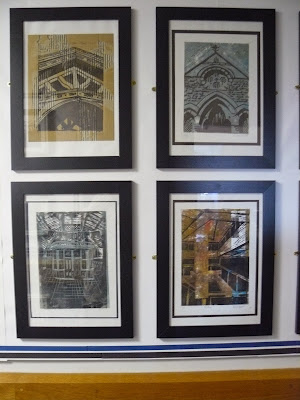The TRCreative Enterprise project was launched
in 2011 when students at Thomas Rotherham College secured funding to set up
their own business in order to raise funds for their Art Department and a local
Charity. In the first year students created their own black and white Drypoint
prints inspired by beautiful places in South Yorkshire, these were sold as
Original prints, digital prints, postcards and notecards.
In 2012 students were inspired by portraiture
and focussed their images on the people of South Yorkshire, this year students
have again been inspired by the beautiful places in Yorkshire, but have
interpreted them using Lino for the first time, and experimenting with colour.
From Scarborough Lighthouse to the Cheesegrater building in Sheffield, the
students have produced a wide range of images. Each student has donated their
best print to the project and the original has been framed ready to buy. We have also made an edition of 4 digital
prints of each image which are signed by the students and available framed or
unframed. This year’s logo was designed by Heather Ward, one of our current
students.
This year we will be supporting the Bluebell
Wood Children’s Hospice, half of all profits from items sold will go towards
the charity.
All the prints are now on display outside the
Principal office and are available to buy, along with some other products;
 |
| Notecards and Postcards |
 |
| 2014 Calendar |
Prices:
£25.00
|
Framed Original Prints
These
are the original prints made by the students as A/P’s (Artists proofs) and
are one offs
|
£15.00
|
Framed Digital Prints
These
are digital reproductions of the original prints, printed onto cartridge
paper and signed by the Artist. They
have been produced in an edition of 4 and are available framed
|
£5.00
|
Unframed Digital Prints
These
are digital reproductions of the original prints, printed onto cartridge
paper and signed by the Artist. They
have been produced in an edition of 4 and are available unframed
|
£4.50
|
A4 Wall Calendar
Featuring
prints for each month of next year
|
£2.50
|
Desk Wall Calendar
Featuring
prints for each month of next year
|
£1.50
|
Notecards
Pack
of 5 notelets with various images
|
£1.00
|
Postcards
Pack
of 5 postcards with various images
|
If you would like to buy something please email sarah.mellor@thomroth.ac.uk
with the item you would like to buy and how you would like to pay. Payment can
be made by cash or cheque either to the Art Department or direct to
accounts. If you would like a framed
print please allow some time for this to be taken down.
The original framed
prints (£25.00) are proving very popular, we have already sold the following (digital
prints still available! (£15.00 framed, £5 unframed):
Lucas Edwards ‘Thomas
Rotherham College’
Bronya Roberts ‘Cheesegrater’
Sophie Burton ‘Untitled'
Sian Smith ‘Sheffield
City Hall’




















































